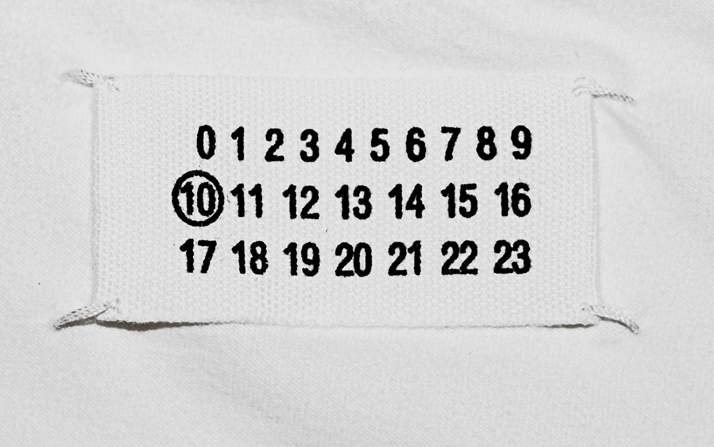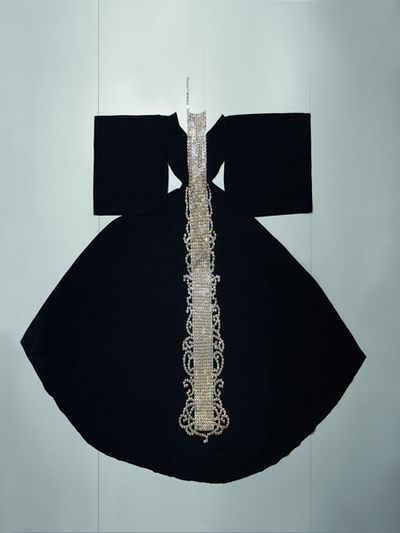
Portrait of Jeanne Lanvin by Harcourt. © Patrimoine Lanvin

Jeanne Lanvin draping a fabric on a model. © Laure Albin Guillot / Roger-Viollet
A few weeks ago during Paris fashion week, the Palais Galliera in close collaboration with Alber Elbaz (artistic director of Lanvin) opened an historical exhibition dedicated to the work of Jeanne Lanvin.
Contemporary of Coco Chanel, Elsa Schiaparelli, and Madame Vionnet, Jeanne Lanvin began her career around 1885 when she first established her own milinery business on rue du Marché-Saint-Honoré. At this time she mainly created hats, dolls, and dresses for young girls and their mothers. A few years later she moved the store to 22 rue du Feaubourg-Saint-Honoré to finally own the whole building by 1918. She was a diligent and creative entrepreneur. Today Maison Lanvin headquarters remains in this prestigious location and can claim to be the oldest fashion house still active in business.
The exhibition focuses on the different facets of the Lanvin legacy, and follows a chronological order through the rooms of the neo-renaissance building. In the salon d’honneur stands the illustrated life of Madame Lanvin with photographic portraits, personal wardrobe, and a focus on the logo’s history designed by Paul Iribe and originally taken from a photograph of Jeanne Lanvin and her cherished daughter Maguerite. Her passion for the blue color is à l’honneur. We learn that the Blue Lanvin was inspired by her cult for Fra Angelico and Gothic stained-glass windows. She was such a visionary designer that she even founded her own dye factory. Over her career she created thousands of precious and beautiful models. The robes de style which were designed in the 1920s to ressemble court dresses of the 18th century in complete opposite of the tubular figure of that time, encountered a massive hit toward her clients. « ‘The name Lanvin for me,’ Christian Dior wrote nostalgically much later, ‘was bound up with the memory of girls in robes de style whom I danced my first foxtrots, Charlestons and shimmies with. At the balls, they were always the most beautifully dressed.’ The robe de style was surely a harbinger of the New Look.» [Ed. Les Modes, February 1912, p. 18.] Jeanne Lanvin was a virtuose of her time who could combine embroidery and fabrics through a specific set of vocabulary : airiness, topstitchings, intertwinings, spirals, and cut. She was a modern and an accomplished business woman who handled to the very last years of her life in 1946, thousand of highly skilled workers to produce hundreds of models every year, all in different kind of departments (fashion, couture, milinery, perfume, etc.
This exhibition is a rich survey on the palpable and quieter traces Jeanne Lanvin left through the history of fashion. A catalogue to accompany the exhibition has been especially published, with an introduction written by Palais Galliera’s director Olivier Saillard.
Excerpt from the introduction:
“[Alber] Elbaz admits that he had never really wanted to know too much about this fashion house which made blue both a banner and a color chart: it can make you too modest. And yet, it is he who has now given it a precise identity. If Chanel invented modernity annexed to media logistics, and
Schiaparelli took art as her spouse, if Grès was the embodiment of technique and Vionnet that of virtuoso cutting, Lanvin was the first to give overall thought to lifestyle. The many different departments that Jeanne Lanvin set up (fashion, haute couture, millinery, children’s clothes, men’s
tailoring, interior decoration, etc.) still act today as the basis for a kind of fashion design that Elbaz thinks of as ‘express’.

Drawing Maison Lanvin ” Les petites filles modèles “, 1925. © Patrimoine Lanvin

Dress for child ” Les petites filles modèles “, 1925. Organdie embroidered with bows in organdie and lace. Patrimoine Lanvin. © Katerina Jebb, 2014

Robe de style “Colombine”, winter 1924-1925. Ivory silk taffeta, black silk velvet appliqués, large, flat beads embroidered with gold thread, red silk velvet bow. Collection Palais Galliera. © Katerina Jebb, 2014

Evening ensemble “Alcmène” (jacket, dress and slip), 1929. Pink silk crêpe, embroidered with Swarovski crystals and silvered tubes. Collection Palais Galliera. © Katerina Jebb, 2014

Evening coat, 1937. Black taffeta, embroidered with layers of gilded sequins. Patrimoine Lanvin. © Katerina Jebb, 2014

Evening gown “La Cavallini”, 1925. Black taffeta, bow embroidered in silver threads, beads, Swarovski crystals and fine pearls. Patrimoine Lanvin. © Katerina Jebb, 2014

Summer shirt “Vogue”, 1924. Silk velvet, embroidery of tubes, round mirrors and crystals Swarovski. Collection Palais Galliera © Katerina Jebb, 2014

Evening gown ” La Diva “, winter 1935-1936. Midnight blue velvet silk, embroidery of superimposed silvery metallic glitter. Collection Palais Galliera © Katerina Jebb, 2014

Summer dress “Marguerite de la nuit”, 1929. Silk tulle, satin silk flower topstitched, embroidery of glitter. Collection Palais Galliera © Katerina Jebb, 2014

Summer dress “Scintillante”, 1939. Tulle, teases embroidery of glitter. Collection Palais Galliera © Katerina Jebb, 2014

Drawing Maison Lanvin « Lesbos & Claire de lune », 1925. © Patrimoine Lanvin

Dress “Lesbos”, 1925. Absinthe green silk satin, embroidered with glass beads and silvered tubes. Patrimoine Lanvin. © Katerina Jebb, 2014
Exhibition running through August, 23rd, 2015
Palais Galliera
Mus.e de la Mode de la Ville de Paris
10, av. Pierre Ier de Serbie 75116 Paris
+33 (0)1 56 52 86 00
www.palaisgalliera.paris.fr



















